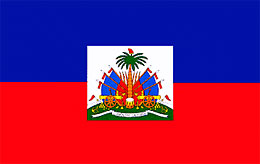Cup Of Joe, Aid To Haiti

The world’s focus right now is on immediate aid to Haiti, as it should be. But it never hurts to look down the road, too: when the repercussions of Haiti’s tragedy settle down – to whatever extent they do – it will be important for other nations, and consumers in other nations (that’s you), to find ways to help bolster not only Haiti’s downtrodden economy, but also help heal its decimated and deforested natural environment. And in fact, an easy way to do both of these things at once also happens to have a lot to do with the best part of waking up.
Coffee. When the US led an embargo against the Haitian dictatorship of the mid 1990’s, Haitian coffee, which had been a primary export for the country, essentially disappeared from menus in most of the world. Farmers in Haiti literally burned their coffee trees to the ground during those years – the charcoal they could produce by burning coffee crops was more valuable at that time than any coffee those crops might yield. Before the earthquake hit, Haitian coffee was beginning to make a comeback, with a new type of coffee called Haitian Bleu (don’t worry, they didn’t misspell blue – that’s the way it’s spelled in French). A socially and environmentally compassionate choice for any coffee addict, Haitian Bleu creates jobs and commerce in Haiti, and is shade-grown, to boot. Win-win.
According to CoffeeResearch.org:
“Haitian Bleu coffee is a relatively new specialty coffee in the Caribbean region. It was introduced to the area in 1995, at a time when the Haitian’s coffee market was suffering. Haitian bleu coffee growers hand pick the coffee cherries, using shade-grown farming methods and wet processing techniques to yield these unique blue-green colored beans. Haitian green coffee beans are also fair trade certified, playing an important role in the livelihood of Haitian coffee farmers. Haitian bleu retailers and those who buy Haiti coffee are helping support one of the poorest populations in the Western Hemisphere.”
Shade-growing 101:
Most coffee farmers, in most of the world, clear forest entirely (rather than planting their coffee under existing trees and rainforest), to increase output, but letting the sun shine in comes with a high ecological and climate-change price tag. First, clearing rainforest is bad news for birds, in sort of the same way that it would be bad news for you if I tore your house down. Second, clearing rainforest causes an estimated 20-25% of greenhouse gas emissions (according to the Climate, Community, and Biodiversity Alliance (CCBA). One of Haiti’s primary ecological crises is its deforestation epidemic, so any crop that incentivizes the planting and maintaining of trees is a critical one for the small island state.
As David Brooks argued in Friday’s New York Times, all the wonderful aid work that has poured into Haiti in recent decades has not had the impact it should. “By some estimates,” writes Brooks, “Haiti has more nongovernmental organizations per capita than any other place on earth.” And yet Haiti is still the poorest country in our hemisphere.
The kind of aid work that’s been in Haiti must continue, but a next step might be to work on creating, as Brooks puts it, “No Excuses countercultures” in the country. And something you and I can incorporate into our daily routine is to invest in Haiti’s economy by supporting Haitian coffee farmers. As with so many social and environmental issues, we consumers hold the power to vote with our wallets, and to contribute to what, collectively, can make a big difference.





